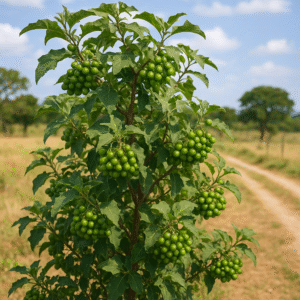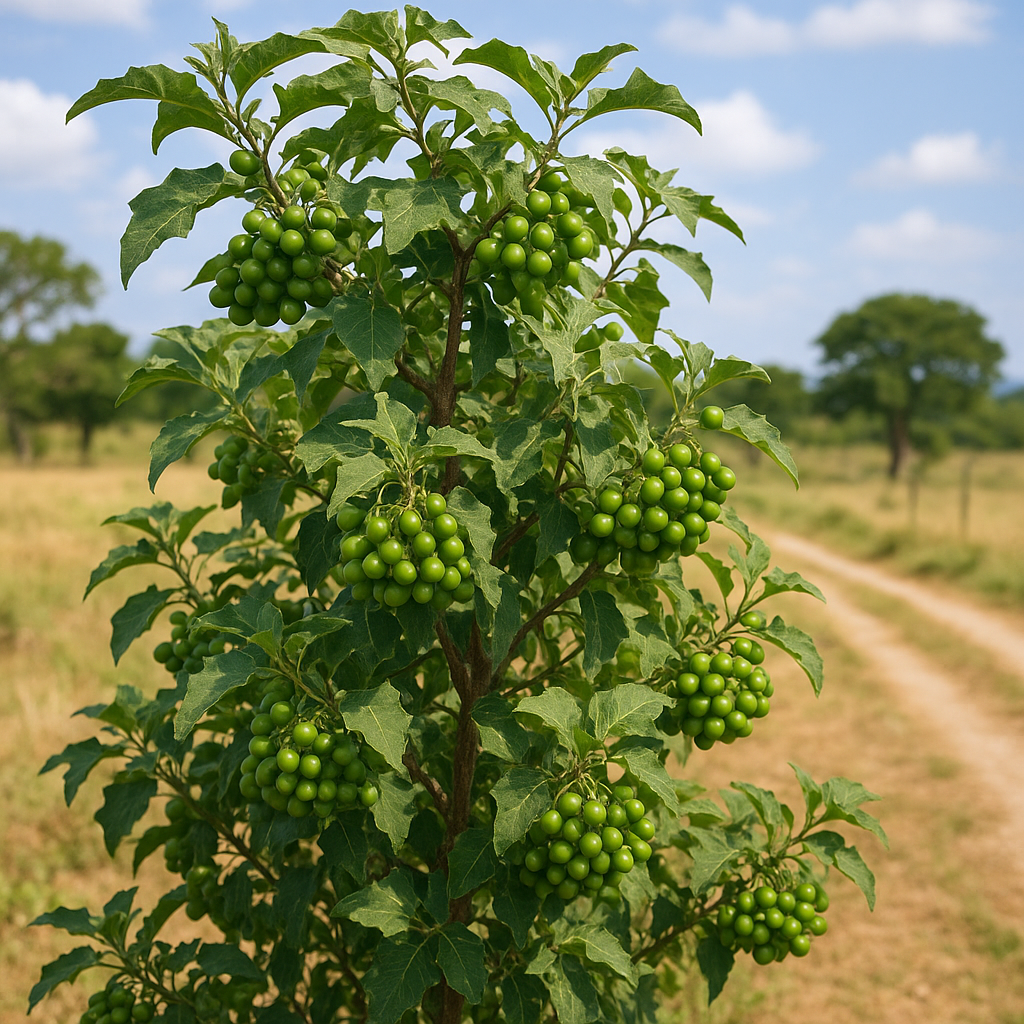Jurubeba is a plant widely known in Brazil, especially for its medicinal and culinary uses. Belonging to the Solanaceae family—the same as potatoes and tomatoes—jurubeba (Solanum paniculatum) is popular for its leaves, roots, and fruits, all of which carry therapeutic properties. In addition, it also appears in preserves and traditional dishes, proving to be a versatile element of Brazilian culture.
In this article, you will learn in detail what jurubeba is, its main uses, and 5 important facts about this plant that make it a true treasure of Brazil’s flora.
What is jurubeba?
Jurubeba is a small shrub that can reach up to two meters in height. Its leaves are broad, with a deep green color, while its fruits are small, round berries that turn yellowish when ripe.
In Brazil, jurubeba grows spontaneously in different regions and adapts well to diverse soils and climates. Because of its rustic nature, it spreads easily across the countryside and is often found in rural environments.
What is jurubeba used for?
Traditionally, jurubeba has always been linked to natural medicine. Indigenous and rural communities used different parts of the plant to treat digestive, liver, and circulatory problems. Today, its use extends to teas, extracts, and even capsules. Some of its best-known applications include:
-
Liver support – helps with digestion issues, bloating, and discomfort linked to the liver.
-
Natural digestive aid – jurubeba tea is widely consumed to improve digestion.
-
Diuretic effect – assists in eliminating retained fluids from the body.
-
Anti-inflammatory action – helps reduce mild inflammation.
-
Culinary ingredient – the fruits of jurubeba are commonly eaten in preserves, often paired with regional dishes such as the famous “carne de sol with jurubeba.”
5 interesting facts about jurubeba
1. A native Brazilian plant
Jurubeba is genuinely Brazilian, found especially in the Northeast and Midwest, though it grows throughout the country.
2. Part of the potato family
Just like potatoes and tomatoes, jurubeba belongs to the Solanaceae family. This explains some similarities in the appearance of its berries and the presence of alkaloids that require moderate consumption.
3. Used in both traditional and modern medicine
From folk remedies to modern phytotherapy, jurubeba continues to hold value. Today, extracts and standardized supplements made from the plant are easily found in compounding pharmacies.
4. Ingredient in bitter tonics
Jurubeba is a classic ingredient in traditional Brazilian bitter drinks, consumed both as appetizers and digestive aids.
5. Should be consumed in moderation
Although beneficial, jurubeba contains compounds that may be toxic if consumed in excess. For that reason, medical or phytotherapeutic guidance is recommended for frequent use.
How to prepare jurubeba tea
Jurubeba tea is one of the most popular ways of consuming the plant. The recipe usually uses dried leaves or fruits:
-
Ingredients:
-
1 tablespoon of dried jurubeba leaves or fruits
-
200 ml of boiling water
-
-
Instructions:
-
Place the jurubeba in a cup.
-
Pour the boiling water over it.
-
Cover and let steep for 10 minutes.
-
Strain and drink while warm.
-
The usual recommendation is up to two cups per day, always with moderation.
Jurubeba in Brazilian cuisine
Besides its medicinal value, jurubeba also plays an important role in Brazilian cuisine. Its fruits, when pickled, are added to several regional dishes. One of the most famous is carne de sol with jurubeba, a strong cultural symbol of the Northeast.
This culinary use shows how jurubeba bridges the gap between health and culture, making it both a remedy and a delicacy.
Contraindications of jurubeba
Like many medicinal plants, jurubeba should not be consumed freely. Some precautions include:
-
Pregnant and breastfeeding women should avoid it.
-
People with severe liver conditions must consult a doctor before using it.
-
Excessive consumption may cause side effects such as nausea and abdominal pain.
Therefore, professional advice is always recommended before frequent or long-term use.
Conclusion
Jurubeba is a versatile plant deeply connected to Brazilian culture. On one hand, it is rooted in popular traditions, being used in teas, tonics, and culinary recipes. On the other, it remains relevant in modern herbal medicine, appearing in extracts and supplements.
With its digestive and anti-inflammatory properties, as well as its important role in regional dishes, jurubeba is truly a gem of Brazil’s flora. However, its consumption should always be balanced and mindful.
These 5 facts about jurubeba highlight why this plant has been valued for centuries and continues to spark interest both in science and culture.

Bianca Rosa Jurubeba Cream (2 oz, ZIN: 524527)
Experience the natural benefits of jurubeba in a practical daily-use formula.
Bianca Rosa Jurubeba Cream is designed to support body care, combining tradition and well-being in every application.
A natural and reliable choice for your wellness routine.

Discover the Advantages of False Heather
False Heather is a versatile and charming plant that thrives both in gardens and pots.
Learn how this ornamental species can enhance your outdoor and indoor spaces with beauty, resilience, and easy maintenance.
A perfect choice for gardeners who value elegance and practicality.

